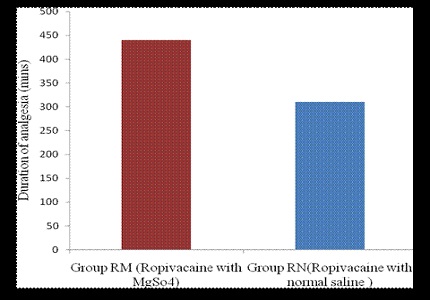Comparison of 0.5% Ropivacaine with 0.5% Ropivacaine and Magnesium sulphate in supraclavicular brachial plexus block for forelimb and hand surgeries
Abstract
Objectives: Supraclavicular Brachial Plexus is commonly used for forelimb and hand surgeries. A lot of research is going on to increase the duration of sensory and motor blockade by the addition of adjuvants with the local anesthetics. We evaluated the effect of adding magnesium sulphate to ropivacaine for supraclavicular brachial plexus blockade. Our primary parameters were the onset and duration of sensory and motor block and duration of analgesia.
Methods: 60 patients posted for elective forearm and hand surgeries under supraclavicular brachial plexus block were divided into two equal groups (Group RM and RN) in a double blind fashion. In Group RM 30ml 0.5% ropivacaine plus 150 mg magnesium sulphate in (1 ml 0.9% saline) and in group RN 1ml of normal saline was added to ropivacaine.
Results: Both the groups have similar demographic profile and time of onset of senory and motor block but the duration of senory and motor blockade and duration of analgesia were significantly longer in RM group than RN group. Intraoperative hemodynamics were compareable amoung two groups and no considerable side effects were noted in both the groups.
Conclusion: It can be concluded from our study that by addition of magnesium sulphate to local anesthetics in supraclavicular brachial plexus block may increase the duration of senory and motor blockade and duration of analgesia with no appreciable side effects, however duration of onset of sensory and motor blockade was more in magnesium sulphate group.
Downloads
References
2. Khanduri KC. Regional Anaesthesia Techniques for Orthopaedic Surgery. Med J Armed Forces India. 2008 Apr;64(2):108-10. doi: 10.1016/S0377-1237(08)80048-2. Epub 2011 Jul 21.
3. Klein SM, Greengrass RA, Steele SM, D'Ercole FJ, Speer KP, Gleason DH, DeLong ER, Warner DS. A comparison of 0.5% bupivacaine, 0.5% ropivacaine, and 0.75% ropivacaine for interscalene brachial plexus block. Anesth Analg. 1998 Dec;87(6):1316-9. [PubMed]
4. Bazin JE, Massoni C, Groslier D, Fenies V, Bittar M, Schoeffler P. [Brachial plexus block: effect of the addition of sufentanil to local anesthetic mixture on postoperative analgesia duration]. Ann Fr Anesth Reanim. 1997;16(1):9-13.
5. Kohli S, Kaur M, Sahoo S, Vajifdar H, Kohli P. Brachial plexus block: Comparison of two different doses of clonidine added to bupivacaine. J Anaesthesiol Clin Pharmacol 2013;29:491-5. doi: 10.4103/0970-9185.119147.
6. Yadav RK, Sah BP, Kumar P, Singh SN. Effectiveness of addition of neostigmine or dexamethasone to local anaesthetic in providing perioperative analgesia for brachial plexus block: A prospective, randomized, double blinded, controlled study. Kathmandu Univ Med J (KUMJ). 2008 Jul-Sep;6(23):302-9. [PubMed]
7. Sirvinskas E, Laurinaitis R. [Use of magnesium sulfate in anesthesiology]. Medicina (Kaunas). 2002;38(7):695-8. [PubMed]
8. Telci L, Esen F, Akcora D, Erden T, Canbolat AT, Akpir K. Evaluation of effects of magnesium sulphate in reducing intraoperative anaesthetic requirements. Br J Anaesth. 2002 Oct;89(4):594-8.
9. Koinig H, Wallner T, Marhofer P, Andel H, Hörauf K, Mayer N. Magnesium sulfate reduces intra- and postoperative analgesic requirements. Anesth Analg. 1998 Jul;87(1):206-10.
10. Panda NB, Bharti N, Prasad S. Minimal effective dose of magnesium sulfate for attenuation of intubation response in hypertensive patient. J Clin Anesth 2013;25:92-7. doi: 10.1016/j.jclinane.2012.06.016. Epub 2013 Jan 17.
11. Agrawal A, Agrawal S, Payal YS. Effect of continuous magnesium sulfate infusion on spinal block characteristics: A prospective study. Saudi J Anaesth 2014;8:78-82. doi: 10.4103/1658-354X.125945.
12. Khezri MB, Yaghobi S, Hajikhani M, Asefzadeh S. Comparison of postoperative analgesic effect of intrathecal magnesium and fentanyl added to bupivacaine in patients undergoing lower limb orthopedic surgery. Acta Anaesthesiol Taiwan. 2012 Mar;50(1):19-24. doi: 10.1016/j.aat.2012.03.001. Epub 2012 Mar 31.
13. Malleeswaran S, Panda N, Mathew P, Bagga R. A randomised study of magnesium sulphate as an adjuvant to intrathecal bupivacaine in patients with mild preeclampsia undergoing caesarean section. Int J Obstet Anesth. 2010 Apr;19(2):161-6. doi: 10.1016/j.ijoa.2009.08.007. Epub 2010 Feb 18. [PubMed]
14. Ekmekci P, Bengisun ZK, Akan B, Kazbek BK, Ozkan KS, Suer AH. The effect of magnesium added to levobupivacaine for femoral nerve block on postoperative analgesia in patients undergoing ACL reconstruction.Knee Surg Sports Traumatol Arthrosc. 2013 May;21(5):1119-24. doi: 10.1007/s00167-012-2093-4. Epub 2012 Jun 14.
15. Lee AR, Yi HW, Chung IS, Ko JS, Ahn HJ, Gwak MS, Choi DH, Choi SJ. Magnesium added to bupivacaine prolongs the duration of analgesia after interscalene nerve block. Can J Anaesth. 2012 Jan;59(1):21-7. doi: 10.1007/s12630-011-9604-5. Epub 2011 Oct 20. [PubMed]
16. Choi IG, Choi YS, Kim YH, Min JH, Chae YK, Lee YK, et al. The Effects of Postoperative Brachial Plexus Block Using MgSo4 on the Postoperative Pain after Upper Extremity Surgery. Korean J Pain 2011;24:158-63. doi: 10.3344/kjp.2011.24.3.158.
17. Woolf CJ, Thompson SW. The induction and maintenance of central sensitization is dependent on N-methyl-D-aspartic acid receptor activation; implications for the treatment of post-injury pain hypersensitivity states. Pain. 1991 Mar;44(3):293-9. [PubMed]
18. Ascher P, Nowak L. Electrophysiological studies of NMDA receptors. Trends Neurosci 1987;10:284-8.
19. Woolf CJ, Chong MS. Preemptive analgesia--treating postoperative pain by preventing the establishment of central sensitization. Anesth Analg. 1993 Aug;77(2):362-79. [PubMed]
20. Liu HT, Hollmann MW, Liu WH, Hoenemann CW, Durieux ME. Modulation of NMDA receptor function by ketamine and magnesium: Part I. Anesth Analg. 2001 May;92(5):1173-81.



 OAI - Open Archives Initiative
OAI - Open Archives Initiative


